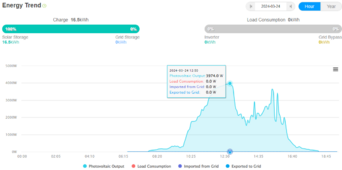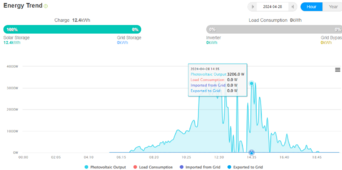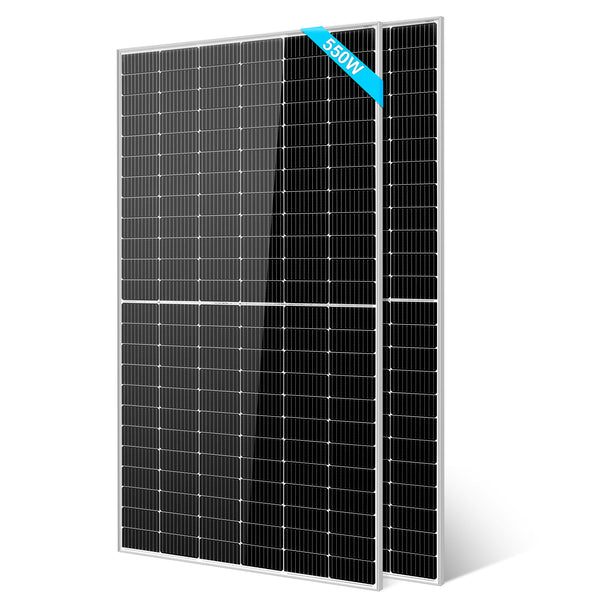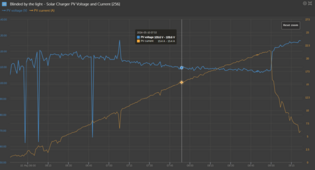MWeiss
New Member
- Joined
- Apr 22, 2020
- Messages
- 95
For background context, in April of last year, I installed an array of sixteen Sungold Power 450W panels (bottom photo, right hand two front most arrays).
I quickly found that the new panels were my biggest energy producers in all weather conditions. I measured the power to the batteries on the Growatt SC48120 controller and calculated that they were putting in 93% of nameplate rating.
By comparison, my old Trina solar 240W panels in two groups of 20 (top photo before upgrade) were making about 75% of nameplate. I was seeing 3200-3600W from that 4800W array. In addition, in Dec.-Jan., the bottom third of the Trina panels were in shade from the array in front of it. Those are on a Growatt SC4880 controller.
Naturally, I thought it would be a good idea to upgrade the Trina panels which were decades old (bought used) when Sungold had a 25% discount last November. I ordered a palette of sixteen panels, intending to swap out all of the Trina panels in two arrays.
Based on 93% expected output, I predicted that 8 550W panels (4400W nameplate) would make 4050W in practical terms. So I did the swap out 2 weeks ago. Second photo is the new array.
I was stunned that the new panels are only making 72% of nameplate rating.
I used a Fluke IRR-1 to measure irradiance at the peak solar hour for this array and it was 1027W/sq mtr. So based on that, I should be seeing 4400W output. However, I am seeing only 3200W and less. Furthermore, the overcast performance of the new panels was even worse, falling behind the other Trina panels by 34% on dark cloudy days. (160W vs 280W) My other Sungold array makes over 700W in the rain.
As such, I am hesitant to replace the other 20 Trina panels, as I would be losing some 10-20% of production.
When I built the 7200W array last year, they were the only panels that were connected to the SC48120 charge controller.
However, this array in question had the 20 Trina panels connected in a 5S 4P configuration for about 2 years. Then I shut down the controller, did the swap out and the new array is 4S 2P. At noon, I have 11 amps of current measured by current probe on each leg of the two parallel groups of panels. I should be seeing well over 13 amps. The open circuit voltage is lower than expected too, at 180V with the controller off. Should be close to 200V being each panel is 49.9V open circuit and I have over 1000W/sq mtr at the time of measurement.
I tried washing the new panels and checking all connections.
The next test was to disconnect all panels and test each one with a 2 ohm resistive load and measure current and voltage. The panels produced about 13.2-13.7 amps at around 27V each, individually. I know this is not maximum power point, but just to see if any panels are weak or underperforming.
On one hand, I'm pondering if the Growatt controller 'trained' itself on the old panels and is not adjusting to the new configuration, so not making optimal power?
I've got Sungold support on the case, but they're as baffled as I am.
PHOTO: OLD TRINA PANELS
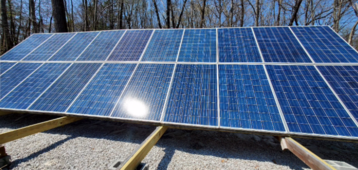
PHOTO: NEW SUNGOLD 550W PANELS
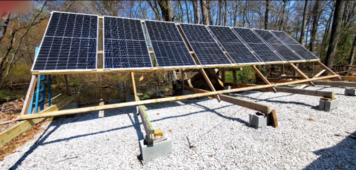
PHOTO: RIGHT SIDE FRONT ARE FIRST SUNGOLD ARRAY OF TWO ROWS OF PANELS. BACK IS NEW REPLACED SUNGOLD 55O0W PANELS
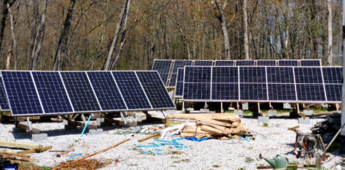
I quickly found that the new panels were my biggest energy producers in all weather conditions. I measured the power to the batteries on the Growatt SC48120 controller and calculated that they were putting in 93% of nameplate rating.
By comparison, my old Trina solar 240W panels in two groups of 20 (top photo before upgrade) were making about 75% of nameplate. I was seeing 3200-3600W from that 4800W array. In addition, in Dec.-Jan., the bottom third of the Trina panels were in shade from the array in front of it. Those are on a Growatt SC4880 controller.
Naturally, I thought it would be a good idea to upgrade the Trina panels which were decades old (bought used) when Sungold had a 25% discount last November. I ordered a palette of sixteen panels, intending to swap out all of the Trina panels in two arrays.
Based on 93% expected output, I predicted that 8 550W panels (4400W nameplate) would make 4050W in practical terms. So I did the swap out 2 weeks ago. Second photo is the new array.
I was stunned that the new panels are only making 72% of nameplate rating.
I used a Fluke IRR-1 to measure irradiance at the peak solar hour for this array and it was 1027W/sq mtr. So based on that, I should be seeing 4400W output. However, I am seeing only 3200W and less. Furthermore, the overcast performance of the new panels was even worse, falling behind the other Trina panels by 34% on dark cloudy days. (160W vs 280W) My other Sungold array makes over 700W in the rain.
As such, I am hesitant to replace the other 20 Trina panels, as I would be losing some 10-20% of production.
When I built the 7200W array last year, they were the only panels that were connected to the SC48120 charge controller.
However, this array in question had the 20 Trina panels connected in a 5S 4P configuration for about 2 years. Then I shut down the controller, did the swap out and the new array is 4S 2P. At noon, I have 11 amps of current measured by current probe on each leg of the two parallel groups of panels. I should be seeing well over 13 amps. The open circuit voltage is lower than expected too, at 180V with the controller off. Should be close to 200V being each panel is 49.9V open circuit and I have over 1000W/sq mtr at the time of measurement.
I tried washing the new panels and checking all connections.
The next test was to disconnect all panels and test each one with a 2 ohm resistive load and measure current and voltage. The panels produced about 13.2-13.7 amps at around 27V each, individually. I know this is not maximum power point, but just to see if any panels are weak or underperforming.
On one hand, I'm pondering if the Growatt controller 'trained' itself on the old panels and is not adjusting to the new configuration, so not making optimal power?
I've got Sungold support on the case, but they're as baffled as I am.
PHOTO: OLD TRINA PANELS

PHOTO: NEW SUNGOLD 550W PANELS

PHOTO: RIGHT SIDE FRONT ARE FIRST SUNGOLD ARRAY OF TWO ROWS OF PANELS. BACK IS NEW REPLACED SUNGOLD 55O0W PANELS




